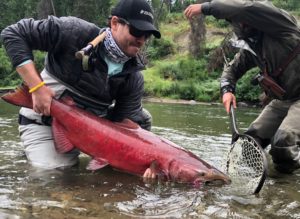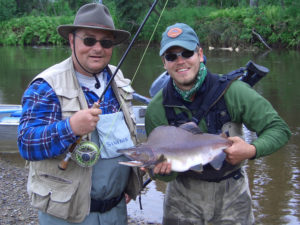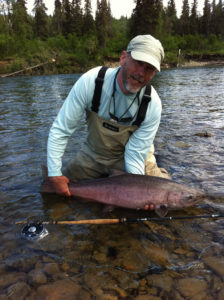0 Comments
Trevor Reid
As an Alaska fly fishing guide when I envision Alaska, a wild empty expanse of tundra, empty wilderness, and a vast expanse of rivers and streams teeming with salmon comes to mind. I remember hearing fairytale stories as a kid and throughout my youth about rivers so thick with fish one could literally walk across their backs. I originally was skeptical about this, as we all know the common premise, fish stories tend to be slightly exaggerated. It wasn’t shortly after my arrival in Alaska however, that I realized these fish tales were anything but a stretch of the truth. Salmon are the states prized resource and there are millions of them. From the ferocious King Salmon, to the aggressive and tenacious silver salmon, there are five unique Alaska salmon species that propagate our waters throughout the state (six if we are to include steelhead in the list of anadromous species). All of them however, have different life cycles and arrive at different times during our short summer months.
Chinook Salmon (The King)

Alaska’s most prized possession, outside of its beautiful landscape, is its mighty King Salmon runs. These magnificent beasts are a driving life force for the state helping support the vast wildlife and ecosystems that thrive here. Arriving in late Spring/early Summer and weighing in at an average of 20-30 pounds (with the larger of them tipping the scales at 60-100 pounds,) these fish can present the fish of a lifetime and it’s easy to understand why. They spend anywhere between 1 to 8 years rearing in the ocean gorging on fatty rich squid, mackerel, and whiting before heading back to their native waters. Arriving in freshwater between late May and early June, they typically hold in deeper runs and channels waiting for the maturation of their eggs. Once they are ready, typically by late July to early August they begin forming reds (nests) and begin actively spawning. Although most of their numbers have significantly declined over the last few decades in most of the lower 48, Alaska is one of the few destinations that still has intact populations. For the fly fisherman, Chinook (King) Salmon present one of the greatest challenges due to their sheer size and aggressive nature. They are a fish worthy of their status as Kings of the salmon and often yank a rod clean out of fisherman’s hands if one isn’t ready for the take. With a fight lasting anywhere between 10 minutes to an hour depending on size, they are truly a worthy adversary for anglers alike. The best time to target these fish is from late may-beginning of July when they first arrive in freshwater and still have strength. Once they start forming reds, there is no targeting kings as it is out of season, and we aim to preserve the species, allowing them to finish a journey they have literally traversed thousands of miles to accomplish.
Silver Salmon (The Acrobat)

The Coho or Silver Salmon, is often the favorite fighting fish amongst the salmon species due to their aggressive nature and acrobatic strikes. They average between 8-12 pounds with some of the larger pushing upwards of 15-20 pounds. Although not quite as large as their Chinook brethren, what they lack in size is made up in their fighting capabilities. Unique to the silver salmon these high energy, hard headed fish will willing strike flies and poppers stripped across the surface. They are easily identifiable for their black mouths deep red colors, and purple fins when they are ready to spawn. The best times to fish for Silvers is in the later part of the summer season towards mid-late August. They typically are found in slow meandering runs and in backchannels of rivers and slews where they tend to pod together.
Sockeye Salmon (The Delectable)

Sockeye salmon are unique species to the salmonids. They are on the smaller side of salmon species averaging 8-9 pounds and spawn in both rivers and lakes. Sockeye fry however, require lakes to rear in during the first few years, before migrating to the ocean surviving on a primary diet of zooplankton. They are widely considered to be the tastiest and most flavorful of the salmon species due to their diet, with particularly bright pink fatty red meat. Sockeyes are identifiable by their bright red skin during spawning, green heads, and large golden eyes. They arrive in our systems typically around the first-second week of July and remain fresh and retainable for around 2 and a half weeks prior to turning and beginning to spawn.
Pink Salmon (The Nuisance)

Pink salmon or humpies, are widely considered to be the nuisance of the salmon species. Although one of the more flavorful salmon when in saltwater and first reentering freshwater, they begin to turn almost immediately. Pinks have a tendency to arrive in droves, in numbers unlike any of the other species. Their numbers can fill a system and turn rivers black with bodies. Their spawning grounds are typically in the mainstems of rivers and tributaries, relatively close to saltwater. Pinks are one of the few salmon that do not spend time in freshwater after hatching, instead opting to head straight for saltwater. Pinks are identifiable as their name suggests, by a pink and grey top with a creamy underbelly color while spawning. Their most prominent feature however is in males, who like Sockeye, develop large humps on their backs when nearing spawning. They typically arrive in mid-late July and usually are spawned out by mid August.
Chum Salmon (The Dog)

Chum Salmon are often found in the same streams as Coho or silver salmon. During development while spawning, Chum develop large canine like teeth giving them the nickname Dog Salmon. They average between 10-15 pounds with larger fish reaching upwards of 30 pounds and can prove to be a rather aggressive fun fighting fish. They are like Pink Salmon in that their normal spawning grounds are typically lower throughout systems. Their fry spend little to no time in freshwater, opting to head straight to the estuaries after hatching where they spend several months growing before heading to open ocean. They typically arrive in mid-late July and are like their pink brethren, gone by mid-late august.
If you would like to experience the best Alaska salmon fishing trip of your life, book a trip for 2021. Dates are filling fast, so don’t wait.

Leave a Reply